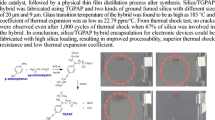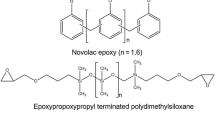Abstract
This research describes thiol-ene/epoxy hybrid networks for core-shell encapsulation of semiconductor devices. A thiol-ene network was formed using ultraviolet-induced radical polymerization, with unreacted thiols and epoxide monomers remaining in the network. Immersion in tributylamine catalyzed the thiol-epoxy coupling to produce a diffusion-limited hard outer shell. Tensile testing shows that the initial thiol-ene product (core) has elastomeric behavior, while the secondary curing creates a glassy material (shell) at room temperature due to thiol-epoxy coupling. Bulk samples of the material form a hard outer shell surrounding a soft core depending on the secondary cure conditions. There are positive relationships between wall thickness and secondary cure temperature and cure time, enabling control of shell thickness by varying reaction conditions. Shell thicknesses were measured up to 1.8 mm when immersed in tributylamine for up to 150 minutes and up to 140 °C. The ability to control core-shell thickness of dual-cured networks is applicable in device encapsulation processes. Core-shell encapsulants for microelectronics may provide further shock and impact protection for durable electronic devices. Further aging and operational studies will be needed to determine time-stability and optimal processing of the core-shell structure.
Similar content being viewed by others

References
Greig, W., Integrated circuit packaging, assembly and interconnections: trends and options. 2007: Springer Science & Business Media.
Van Zant, P. and Chapman, Microchip fabrication: a practical guide to semiconductor processing. Vol. 5. 2000: McGraw-Hill New York.
Hoyle, C.E. and C.N. Bowman, Thiol-ene click chemistry. Angewandte Chemie International Edition, 2010. 49(9): p. 1540–1573.
Hoyle, C.E., A.B. Lowe, and C.N. Bowman, Thiol-click chemistry: a multifaceted toolbox for small molecule and polymer synthesis. Chemical Society Reviews, 2010. 39(4): p. 1355–1387.
Carioscia, J.A., J.W. Stansbury, and C.N. Bowman, Evaluation and control of thiol-ene/thiol-epoxy hybrid networks. Polymer, 2007. 48(6): p. 1526–1532.
Sangermano, M., et al., Preparation and characterization of hybrid thiol-ene/epoxy UV— thermal dual-cured systems. Polymer International, 2010. 59(8): p. 1046–1051.
Author information
Authors and Affiliations
Rights and permissions
About this article
Cite this article
Maaraoui, K.V., Ellson, G. & Voit, W. Hybrid cured thiol-ene/epoxy networks for core-shell semiconductor packaging. MRS Advances 1, 57–62 (2016). https://doi.org/10.1557/adv.2016.59
Published:
Issue Date:
DOI: https://doi.org/10.1557/adv.2016.59



